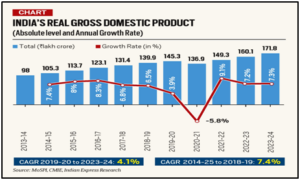Table of Contents
Context: India’s GDP will grow by 7.3% in the current financial year (2023-24), slightly faster than the 7.2% growth in 2022-23, the First Advance Estimates (FAEs) released by the National Statistical Office (NSO), Ministry of Statistics and Programme Implementation (MoS&PI).
What Is the First Advance Estimate?
- Publication: Released end of the first week of January.
- “First” Estimates: Initial official GDP growth estimates for the financial year.
- “Advance” Nature: Published before the financial year (April to March) ends.
- Methodology: Based on data from the first part of the financial year.
- Use: Aids in government and business decision-making.
- Revisions: Subject to change as more data becomes available.
- Economic Indicator: Reflects economic health, influencing markets and investment.
| Note |
| However, it’s crucial to understand that they do not include the formal Q3 GDP data. The detailed Q3 GDP data is released at the end of February as part of the Second Advance Estimates (SAE). |
We’re now on WhatsApp. Click to Join
Key Highlights Of The First Advance Estimates
- Projected GDP Growth by March 2024: India’s GDP is expected to rise to nearly Rs 172 lakh crore (Constant Prices 2011-12).
- GDP Growth History:
- 2014: GDP was Rs 98 lakh crore.
- 2019: Reached almost Rs 140 lakh crore.

- Other Key Estimates for 2023-24:
- Gross Value Added (GVA): Expected to slightly decrease from 7% in 2022-23 to 6.9%.
- Fiscal Deficit: May exceed the target of 5.9% of GDP, reaching around 6%.
- Farm Sector GVA Growth: Estimated to decline from 4% to 1.8%.
- GVA in Trade, Hotels, Transport, and Communication: Projected to moderate to 6.3% from 14% in 2022-23.
- Manufacturing GVA Growth 2023-24: Estimated to accelerate to 6.5%.
- Notably higher compared to just 1.3% in the previous year.
- Mining GVA Growth: Expected to increase to 8.1% in 2023-24, up from 4.6% in 2022-23.
- Overall Economic Growth: A real growth rate of 7.3% has been estimated for 2023-24.
- Reasons for Economic Growth: Boosted by increased state capital spending.
- Expansion in manufacturing activities.
- Future Projections by S&P Global Ratings: India is anticipated to remain the fastest-growing major economy over the next three years.
- Projected to become the world’s third-largest economy by 2030.
What is Contributing/Dragging India’s Current GDP Growth?
- Private Final Consumption Expenditure (PFCE): The current year’s demand growth is expected at 4.4%, aligning with the CAGR of 4.5% during the government’s second term but lower than the 7.1% in the first term.
- There’s a noticeable disparity in consumption growth – urban rich consumption is rising rapidly, whereas rural areas are lagging in recovery.
- The subdued performance of private consumption, a key growth driver, is worrisome, despite the need to balance consumption with income.
- Gross Fixed Capital Formation (GFCF): Investment growth is at 9.3% in the current financial year, bringing the second term’s CAGR to 5.6%, closer to the first term’s 7.3%.
- The majority of investment spending originates from the government, with private consumption remaining low.
- Government Final Consumption Expenditure (GFCE):
- The smallest contributor in this method.
- Accounts for around 10% of GDP.
- Government spending growth is even slower than private demand growth, at just 3.9% this year.
- Net Exports:
- Often negative in India’s case.
- A negative sign in net exports indicates higher imports than exports, contributing to a -3 percentage point drag on real GDP growth due to weak global growth and external sector challenges.
| What Is Gross Value Added (GVA)? |
| GVA represents the monetary worth of all goods and services produced within a country, deducting the expenses of inputs and raw materials directly associated with their production. |
| What Is the Expenditure Method? |
| The expenditure method calculates GDP by summing up consumption, investment, government spending, and net exports– the demand side of the economy, and is the most widely used approach for GDP estimation. |


 Dalai Lama Confirms He will have a Succe...
Dalai Lama Confirms He will have a Succe...
 Transforming Remittances Landscape in In...
Transforming Remittances Landscape in In...
 QUAD Countries: Members, Objectives, Imp...
QUAD Countries: Members, Objectives, Imp...





















